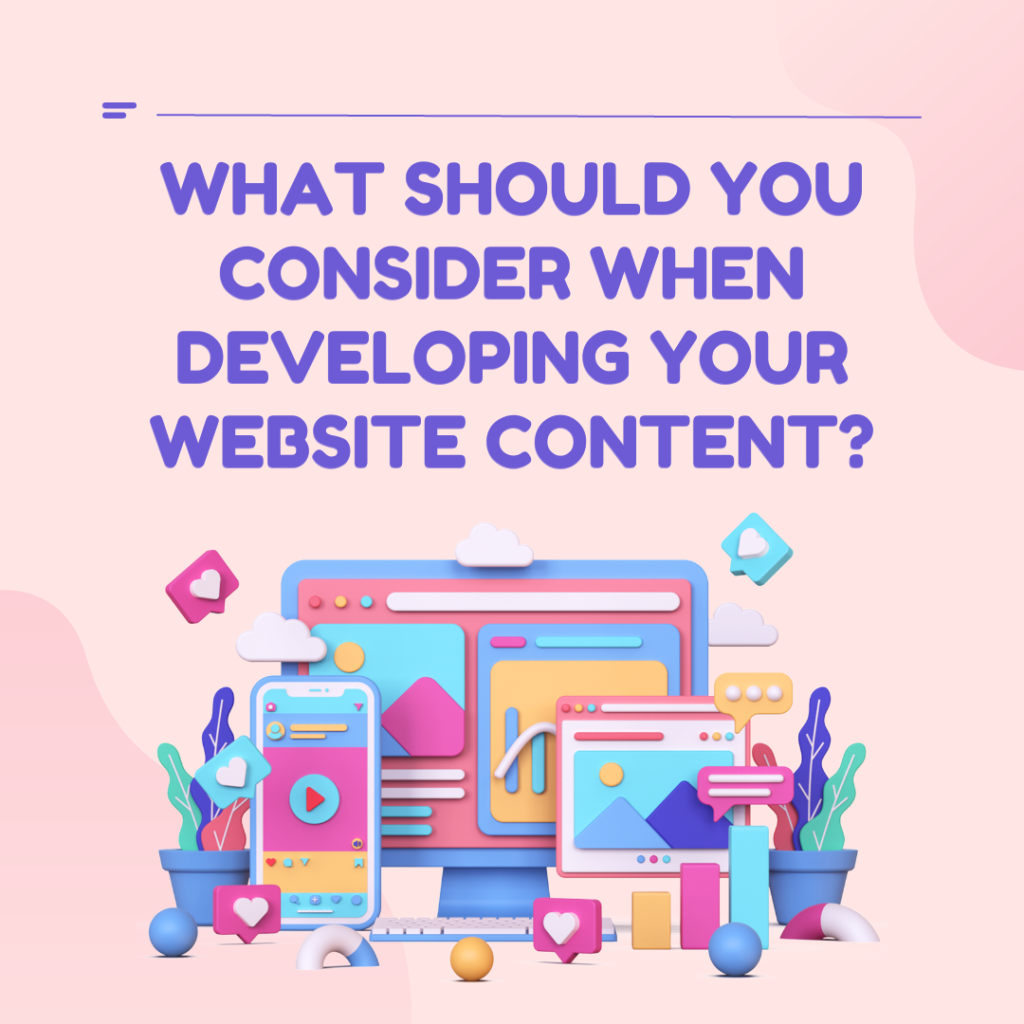What should you consider when Developing your Website Content? When to start developing your own website, or if you want to give yours some updates, one of the most important parts of the process will be to develop high-quality content. If you don’t have good content on your website, nobody will visit it and you won’t be able to attract new clients and customers!

Search Engine Optimization (SEO) is one of the most important aspects of running a successful website, especially if you have plans to generate revenue or increase your company’s visibility on the internet. Before you can optimize your website and its content, it’s important to know what factors to take into consideration when creating your page’s content. Read this guide on the top 5 things you should consider when developing your website content if you want to make sure your efforts are well worth it!
1). Who is your target audience

The first thing you should consider when developing your content is who your target audience is. Is it professional, business-oriented individuals? Young men and women of college age? Stay-at-home moms or retired people? Without a target audience in mind, you’re sure to write content that will confuse and bore most people—not exactly what you want!
Make sure you have a specific audience in mind before starting out on your writing. Here are a few tips for choosing a target audience: Choose an age range—the younger, or older they are, will determine how down their level you need to go with your tone of voice and language.
For example, teenagers probably won’t appreciate overly complicated words or complex sentences!
Choose a gender—if you’re writing for women, do you need more information on fashion or diet? If your target audience is men, what kind of sports news are they interested in?
Just make sure to stay within your target audience’s typical interests when selecting new topics. For example, if you’re writing for teenage girls then don’t cover political or business news. It just won’t interest them!
2). How will you format it

The format of your site plays a big role in how you develop your content. If your website is already established, it’s likely that you’ve got a general idea of how you want it formatted. Maybe you want all of your pages on one page or perhaps you plan to break it up by category, so people can sort through things easily.
Whatever approach you choose for formatting, think about how that will affect what type of content needs to be created and posted on your website.
For example, if you’re going with a more straightforward layout that lists information from A-Z, then there won’t be much need for creating complex graphics or web pages using photos or video.
If you’re new to creating a website, then it may be hard to decide how you want your website to look and feel. Just start brainstorming! Think of anything that would work with your business, like adding links or photos, or videos.
You can even just write out ideas on a whiteboard until you come up with something solid. If all else fails, try doing some basic research online for examples of sites that have similar content and styles as what you’re looking for in yours.
3). How will you develop fresh content

One way is to outsource it. While you could get someone in another country on a freelancer site like Upwork, Freelancer,or maybe a digital marketing agency, you’ll have better luck if you find someone local. That person will be able to tap into your customer base and better understand your business. More importantly, they’ll also be more motivated; when they see your customers, they can identify with them and have a greater desire to work hard for that kind of recognition and feedback. You can put up ads seeking website content writers in your local community (it’s usually free) or ask around through personal connections.
Another option is to use a content management system that lets you update your website. As long as you have some writing skills, you can churn out updates yourself. Look for one with an intuitive user interface and strong support options, since it’s likely that at some point you’ll need help along the way.
4). Where does the content go
The first thing to decide is where your content will live on your website. Most websites contain a mix of different types of content, such as blogs, landing pages, product pages, etc. Before you begin writing (or creating) your content, you’ll need to determine which type of content it is and where that type of content should be placed on your site.

For example: If you are creating an online store with product descriptions then that might go on a products page; if you’re launching a new digital magazine and want people to register for future updates then that might go on a subscribe page; if you’re starting up a company Newsblog then that might go in your blog area.
It is always essential that you organize your content so it is easy for people to navigate and find what they’re looking for. If people can’t easily navigate through your website, then all of your time and effort creating a new website will be wasted. Think carefully about how you want users to move around on your site, keeping in mind that first impressions count.
5). How will you market it
If you can afford a full-time marketing professional, by all means, hire one. But if your marketing strategy comes out of your personal social media feeds, think again. A good content plan looks at how people use multiple channels and then focuses on what works best for each one. You might be good on Twitter but bad on Facebook; vice versa with another competitor.

By looking at these different channels as separate opportunities—rather than lumping them into marketing—you can figure out where you’re strong and where there is room for improvement. From there, it’s a matter of figuring out how much time to spend in each area and which tactics give you the biggest return on investment in that channel.
It’s not enough, however, to create a great strategy and tell people about your business on social media. You have to know how people want you there. No one knows what works better than you—after all, it’s your business—so take some time every week (or even day) and check out what other companies are doing on your key social channels. Watch for differences in tone from channel to channel, or from competitor A to competitor B. Identify what works well for those that sell similar products as you—and then replicate it!
